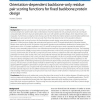100 search results - page 18 / 20 » Predicting protein folds with structural repeats using a cha... |
BMCBI
2006
13 years 7 months ago
2006
Background: The aim of protein design is to predict amino-acid sequences compatible with a given target structure. Traditionally envisioned as a purely thermodynamic question, thi...
CORR
2010
Springer
13 years 7 months ago
2010
Springer
Abstract. The paper investigates a novel approach, based on Constraint Logic Programming (CLP), to predict the 3D conformation of a protein via fragments assembly. The fragments ar...
BMCBI
2010
2010
Orientation-dependent backbone-only residue pair scoring functions for fixed backbone protein design
13 years 7 months ago
Background: Empirical scoring functions have proven useful in protein structure modeling. Most such scoring functions depend on protein side chain conformations. However, backbone...
BMCBI
2007
13 years 7 months ago
2007
Background: We examine the accuracy of enzyme catalytic residue predictions from a network representation of protein structure. In this model, amino acid α-carbons specify vertic...
BMCBI
2010
13 years 7 months ago
2010
Background: Biological networks offer us a new way to investigate the interactions among different components and address the biological system as a whole. In this paper, a revers...

